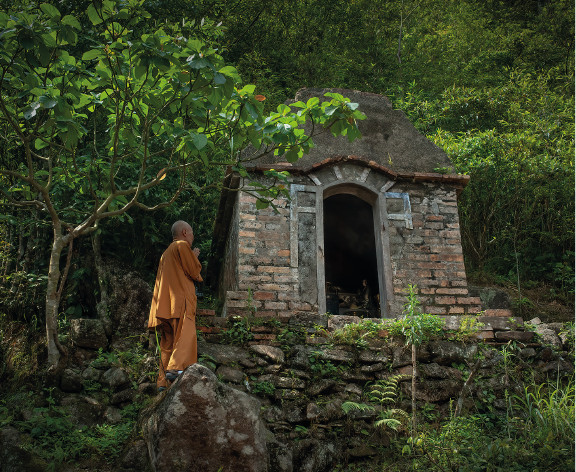Ở đời vui đạo hãy tùy duyên
Đói đến thì ăn mệt ngủ liền
Trong nhà có báu thôi tìm kiếm
Đối cảnh vô tâm chớ hỏi thiền.
These lines of this poem clearly express the ideology of "a peaceful mind, a peaceful life" of the Buddhism King Tran Nhan Tong, the First Patriarch and founder of the Truc Lam Yen Tu Zen sect which has united the old Ti-Ni-Da-Luu-Chi, Vo Ngon Thong, and Thao Duong lineages. Truc Lam Yen Tu is a Zen sect that represents the spirit of Dharma in the world, imbued with Vietnamese national identity. With the spirit of Dharma entering the world, it is the role of a Buddha's descendant to devote into their life, rejoice with the joy of the country, suffer with the pain of the nation, and return to a life of spiritual practice when at peace.
Buddhism King Tran Nhan Tong was the third king of the Tran Dynasty, whose real name was Tran Kham. He was born on November 11, the 8th year of Nguyen Phong during the reign of King Tran Thanh Tong (1258).
He reigned as a king for 14 years, and in 1293, he ceded the throne to his son, Tran Anh Tong, and returned to Thien Truong to become Thai Thuong Hoang to guide and help the king become familiar with the management and administration of the country.
Out of respect for the great monks of Yen Tu Zen, in September 1299, when King Tran Anh Tong was mature enough to deal with the country's management, King Tran Nhan Tong officially became a monk and started his asceticism at Tu Tieu peak, Yen Tu mountain with his name as Huong Van Dai Dau Da, and called himself Truc Lam Great Master, founding the Truc Lam Yen Tu Zen sect - a Buddhist Zen sect strongly featuring Viet Nam culture, targeting the ideology: Cu Tran Lac Dao (A peaceful mind- a peaceful life, connecting religion to life (joying religion in life).
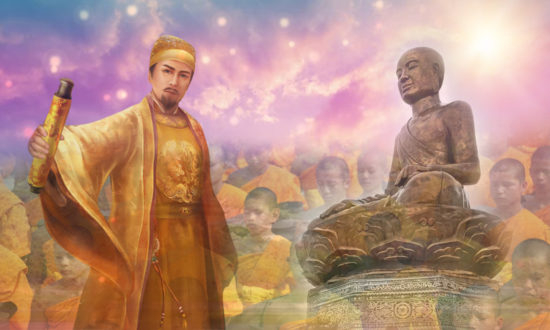
(Buddhism King Tran Nhan Tong)
After more than a year, in 1295, he left Thien Truong palace to practice ordination at Vu Lam palace, Gia Khanh, Ninh Binh.
After a period of ascetic practice in Yen Tu, he went down the mountain and traveled throughout the villages, teaching people to abandon lust, practice the ten virtues, and give medicine to the poor.
In May 1307, Truc Lam Dai Sy became a monk at a small hermitage on Ngoa Van mountain.
On November 1, 1308, he peacefully entered Nirvana at Ngoa Van hermitage. Ngoa Van Pagoda is the place where King Tran Nhan Tong practiced and became Buddha - the Holy Land of the Truc Lam Zen Sect.
The complex of Ngoa Van Pagoda is located on "Bao Dai Son" peak in the west of Yen Tu mountain range in Dong Trieu, today as Tay Son village, Binh Khe commune, Dong Trieu town. This is the Truc Lam Buddhism's sacred Holy Land where the Buddhism King Tran Nhan Tong practiced and became a Buddha. Ngoa Van is one of 14 important relics in the Tran Dynasty relic area in Dong Trieu ranked by the Prime Minister as a special national historical relic (in Decision No. 2383/QD-TTg dated December 9, 2013).
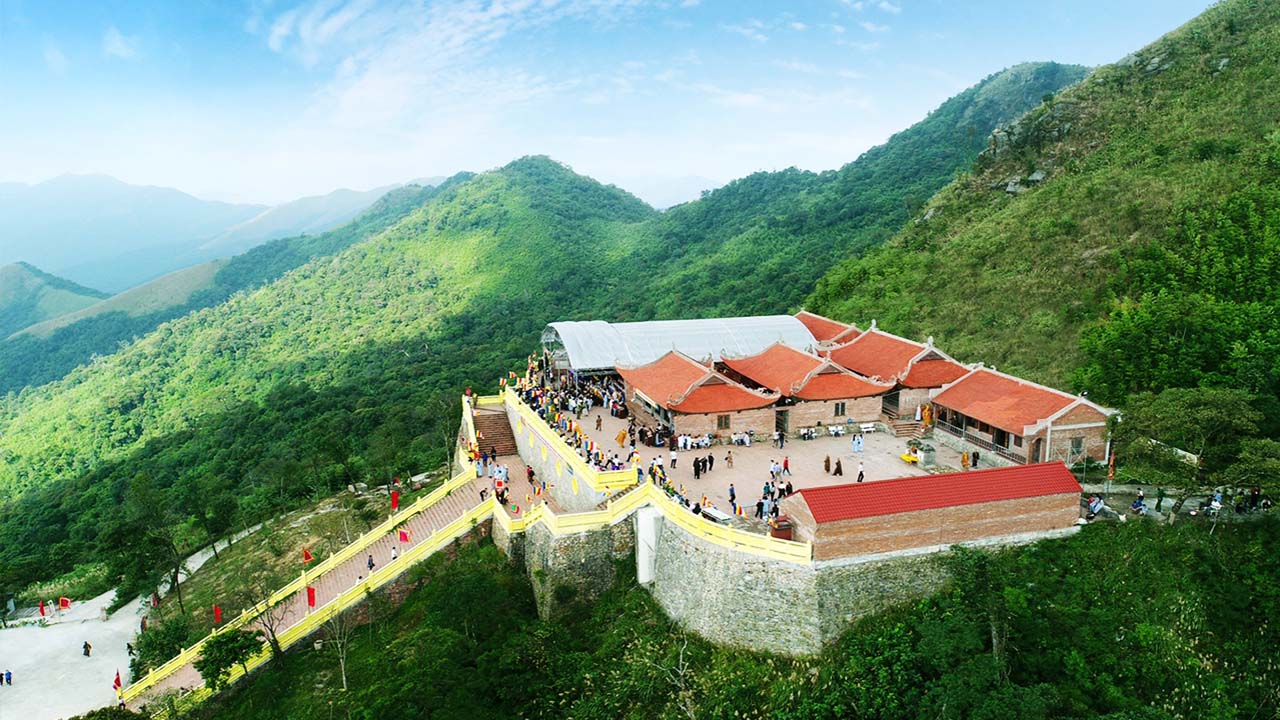
Originated as a small hermitage where the Buddhism King practiced and transformed into Buddha, Ngoa Van was expanded by the Tran Dynasty and the second founder of Truc Lam Zen sect - Phap Loa, to become a large pagoda and tower relic complex on Bao Dai mountain. This is an architectural complex of pagoda and tower of Truc Lam Zen sect in the west of Yen Tu mountain range.
The name Ngoa Van was originally the name of a mountain peak on Bao Dai mountain covered with clouds all year round. Ngoa Van means "in the Cloud". Ngoa Van peak is located on Bao Dai mountain in the Yen Tu mountain range around Dong Trieu. It is shielded by a high mountain range (Vay Rong Mountain) in the North where the moist from the sea is blocked and condenses into clouds, causing the cloudy all over southern slope of Vay Rong Mountain, creating a hazy, slightly mysterious scene. Therefore, this place is called Ngoa Van. Ngoa Van pagoda means that the pagoda is located on the clouds. Ngoa Van Peak is read and written in Sino-Vietnamese pronunciation as Van Phong, so Ngoa Van Pagoda and Ngoa Van Am are also called Van Phong Pagoda and Van Phong Am.
NGOA VAN IS FORMED INTO THREE LAYERS:
The first layer (highest): Ban Co Tien, Ngoa Van Thuong (the upper pagoda) and Buddhism King tower hermitage area.
Second layer: Ngoa Van Trung Pagoda is located 200m southwest of the upper pagoda.
Third layer: The remaining relics at the foot of the mountain including: 4 clusters and 15 different relics such as: Thong Dan, Do Kieu, Da Chong, Ba Bac, Tan Long, Cua Phu.
THE FIRST LAYER
The highest layer is the area where Ngoa Van Thuong pagoda (the upper pagoda) and the tower hermitage site.
The architecture of Ngoa Van pagoda from the Tran dynasty is small in scale, facing southwest. By the 15th century, during the Le dynasty when Confucianism was the state religion, this area was not cared for and seriously degraded. Until the reign of Le Trung Hung that Buddhism flourished again, pagodas and stupas were cared for and built spaciously by the aristocracy. Notably, the year Dinh Hoi (1707), the era of Vinh Thinh and Ngoa Van, was the largest restored. During the French defense period, this area was heavily damaged and ruined by enemy raids. By 2002, Ngoa Van Upper Pagoda was restored to its present state. The remaining architecture is currently concentrated at 2 foundation levels:
Ground Level 1:
It is the yard of the upper pagoda, 3m lower than the pagoda floor. There are two quite large stone lotus-shaped Buddhist towers: Buddhism King Tower and Doan Nghiem Tower. The two towers are constructed of semi-laterite, in square shape consisting of one base, two floors and a gourd-shaped top.
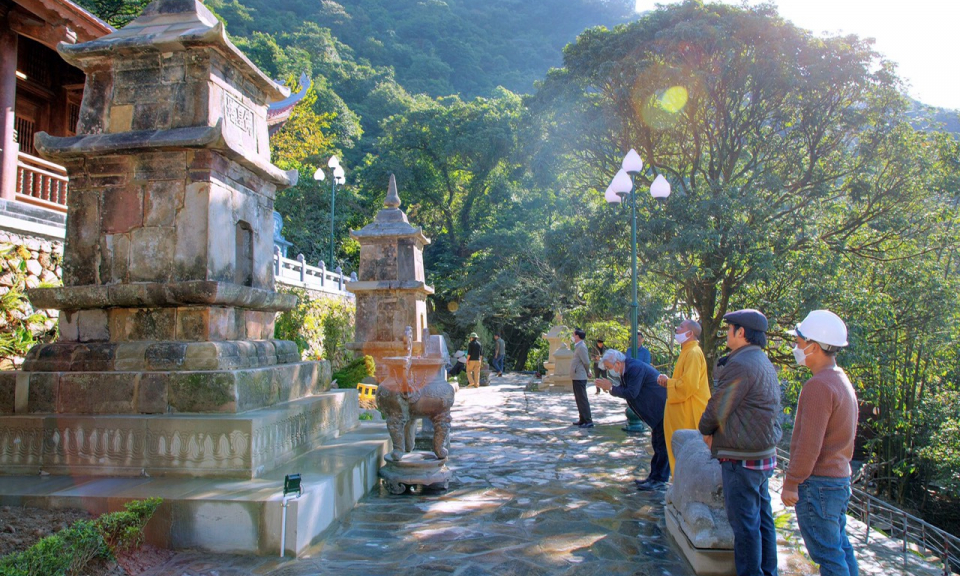
Buddhism King tower and Doan Nghiem Tower.
Buddhism King Tower is located in the west of the foundation level, built by Phap Loa during the Tran dynasty, where the relics of Buddhism KingTran Nhan Tong were kept. During the reign of Le Trung Hung (18th century), the tower built by Phap Loa was ruined. In 1707, Zen master Duc Hung (named Vien Minh) had it restored and rebuilt. In front of the tower, there is a stone elephant statue and a stone stele carved in the year Minh Menh 21 (1840). There is one blue stone ancestral tablet, embossed with seventeen Chinese characters "Nam mo de nhat to Truc Lam Dau Da Tinh Tue Giac Hoang Tran trieu đe tam Nhan Tong Hoang de Dieu Ngu vuong Phat”- (Nam mo a di da phat. Bai vi tho Dieu Ngu Vuong Phat Dau Da Tinh Tue Giac Hoang, to thu nhat phai Truc Lam, vua thu 3 trieu Tran, Hoang de Nhan Tong).(The first patriarch of Truc Lam Dau Da Tinh Tue Giac Hoang Tran, third dynasty of King Tran Nhan Tong Dieu Ngu Vuong Buddha" - (worship of Dieu Ngu Vuong Phat Dau Tinh Tue Giac Hoang, first patriarch of the Truc Lam sect, 3rd king of the Tran dynasty, King Tran Nhan Tong).
DOAN NGHIEM TOWER, located on the eastern side of the base, is the tomb tower of Zen Master Duc Hung, who together with the Royal Court since the 18th century, restored and rebuilt Ngoa Van. In the heart of the tower, there is a blue stone tablet embossed with seventeen Chinese characters "Nam mo Thien Lam thich tu ma ha ti kheo Duc Hung Thien su an toa ha” (Nam mo a di da phat. bai vi tho ma ha ti kheo de tu phai Thien Lam, Thien su Duc Hung)" (Namo Amitabha Buddha. An altar for worshiping Zen Master Duc Hung).
The SECOND LAYER:
AM SON THAN (Pagoda for the Mountain's God): Located on the east side, about 10m east of the Patriarch's house, the Mountain God's Pagoda has a rectangular architectural plan covering an area of 9m2, a brick arched roof, a door open on the south side, on the door is embossed a scroll with 3 Chinese characters "Thien Son Tu" meaning "place worshiping the Mountain Gods. On the two side columns, there are a pair of parallel sentences in Chinese characters praising the land where the Buddha's fairyland has lush scenery in all four seasons:
Spelling:
Vạn cổ anh linh tự
Tứ thời cảnh sắc tân
Brief translation:
Forever and ever, the pagoda is blessed
Fresh scenery in four seasons
NGOA VAN THUONG Pagoda (also known as the main hall):
The pagoda has Nhat-shaped architecture restored on the old architecture in 2000, with an area of 50m2. The three rooms are tiled and the walls are made of stone. On both sides of the pagoda's door are a pair of parallel sentences: "All things are innocent - Disaster lies in the human mind" to remind people and express part of the humanistic ideology "human mind is all Buddha's heart" of Buddhism King Tran Nhan Tong in the Truc Lam Yen Tu Zen sect.
Located to the west of ground level No. 2 and 2.5 meters higher than this ground level is Ngoa Van Pagoda - where the statue of King Buddha Tran Nhan Tong is placed with a lying position simulating the Buddha entering Nirvana.
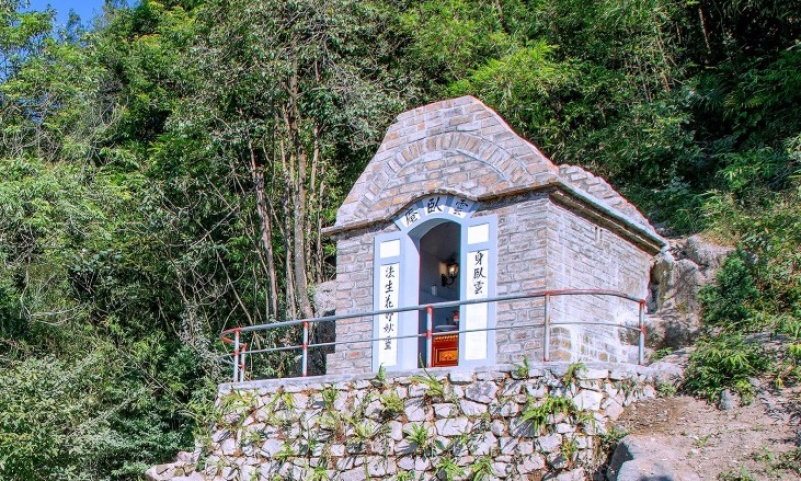
Am Ngoa Van
Ngoa Van Pagoda is built of bricks, with an arched brick roof. The southern side has a doorway, above which are inscribed three Chinese characters "Ngoa Van Am," meaning Am Ngọa Vân. According to legend, when the Buddha King entered Nirvana, he lay in a lion posture on a large rock, which is referred to as the Nirvana Rock. According to the Tran Dynasty's Saint Ancestor documents, the original layout of Ngọa Vân did not include Am Ngola Van; there was only the Nirvana Rock, Ngọa Vân Pagoda, two towers, and a stone stele. Therefore, it is possible that the current Am Ngoa Van was built on the site of the Nirvana Rock where the Buddha King entered Nirvana.
The highest point in this area is Ban Co Tien, which bears traces of an ancient hermitage. The middle Pagoda, the hermitage, and the But Thap (Pen Tower) located in Thong Dan 1 are aligned along a straight path, which is the spiritual axis of Ngoa Van Pagoda.

Plan of Ngoa Van upper pagoda
In December 2020, the Upper Pagoda - Am Ngoa Van began restoration work. The project involved re-planning the entire space and landscape into three zones: Ban Co Tien, the Am Tower area, and the auxiliary ceremonial area. The restoration was based on the existing land and aimed to respect the current terrain and the historical landscape.
Specifically, the project included preserving and restoring the ground level, renovating and completing the transportation system connecting Ban Co Tien with the Am Tower area. It also involved preserving and restoring Am Ngoa Van, Thien Son Pagoda, the two Buddha King and Doan Nghiem towers, restoring the Ancestors' House, and improving the ceremonial space and the transportation system in a way that respects the site's layout and enhances the area's landscape. After nearly a year of construction, the project is almost complete and will be inaugurated on the occasion of the 713th anniversary of King - Buddha Emperor Tran Nhan Tong's entry into Nirvana.
Second Level
The second level of the Ngoa Van relic area is the middle Ngoa Van Pagoda. This Pagoda is located at the central southern slope of Bao Dai Mountain (Vay Rong) at an average altitude of 588m - 644m above sea level.
In 2014, with the support of various authorities and the contributions of many people, a project to restore and rebuild Ngoa Van Pagoda on its old foundation was started and was inaugurated on January 9, 2016.
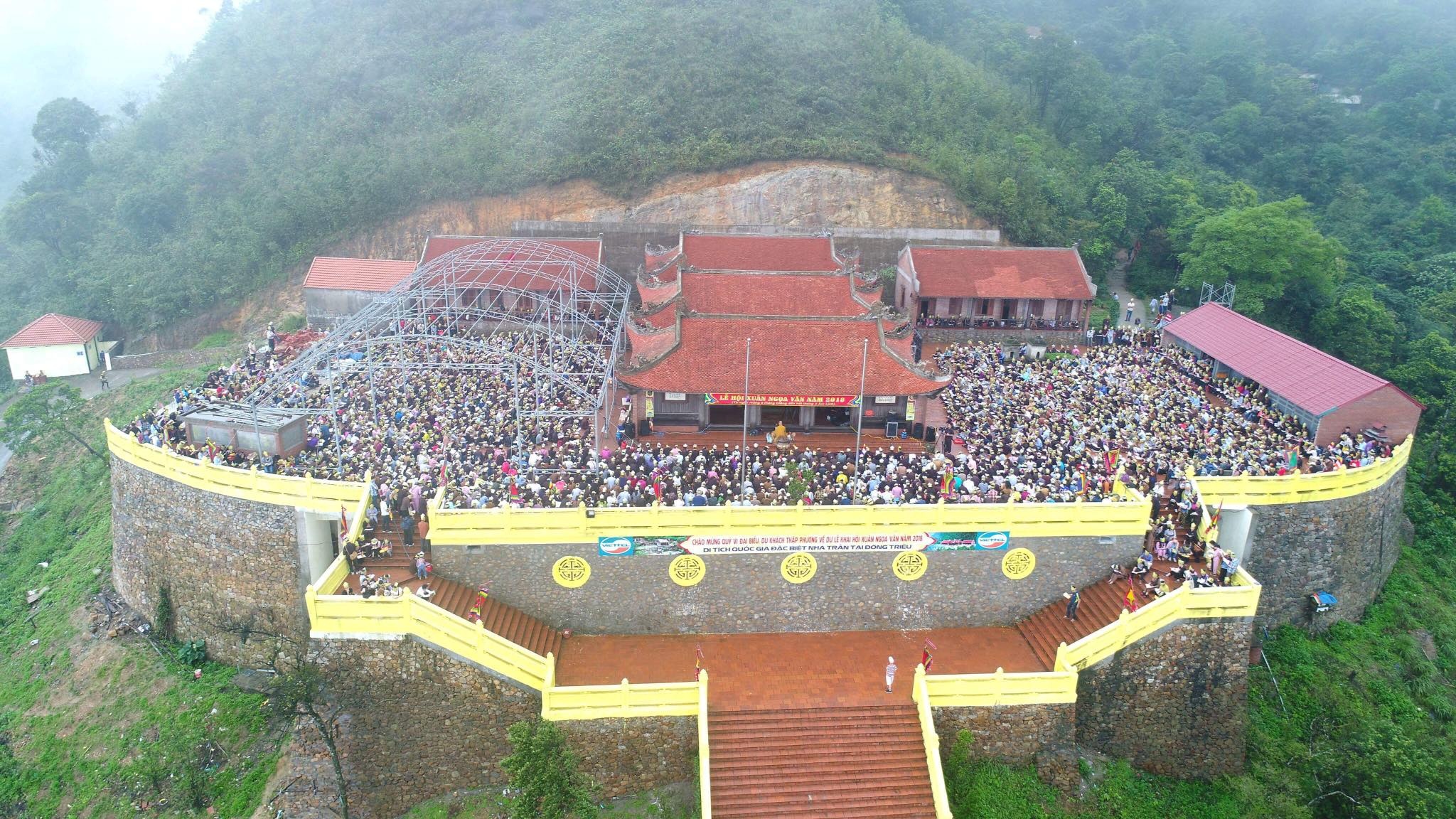
The Pagoda is constructed in the "Nhi" architectural style, which mimics the design of Ngoa Van Pagoda built during the Le Trung Hung period in 1707. The Pagoda consists of two buildings: the front building, Tien Duong, houses a statue of Buddha King Tran Nhan Tong made of red jade. The rear building, Hau Duong, has a three-room, two-wing structure. At the center is the Tam Bao altar, flanked by two Buddhist attendants: Bodhisattva Pho Hien (Samantabhadra) and Bodhisattva Van Thu (Manjushri). The outermost left altar is dedicated to Duc Thanh Hien, and the outermost right altar is dedicated to Duc Ong.
In 2014, with the support of various authorities and the contributions of many people, a project to restore and rebuild Ngoa Van Pagoda on its old foundation was initiated and completed on January 9, 2016.
Third Level
The remaining heritage sites at the foot of Bao Dai - Ngoa Van Mountain are listed according to the walking path from the base of the mountain: Tan Long, Cua Phu Am Tra, Do Kieu, Thong Dan 1, Thong Dan 2, Thong Dan 3, Da Chong, Ngoa Van 1, Ngoa Van 2, Ngoa Van 6, and Ba Bac.
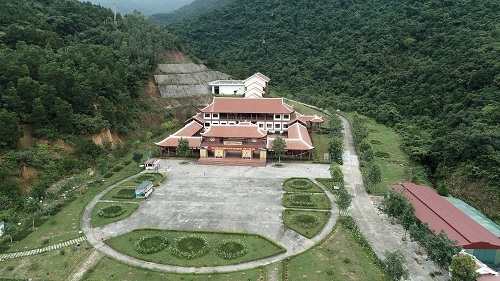
The cable car station is located in the area of the Tan Long relic.
Tan Long
According to local folklore about the ascetic practices and enlightenment of the Buddha King in several villages in the An Sinh and Trang An areas, one must pass through a place called Tan Long before reaching Cua Phu. "Tan Long" means "folding up the canopy." Tan Long is situated on the way up to Am Ngoa Van; from this point, one enters the ancient forest where the path narrows, making the use of a canopy unnecessary and impractical.
The ancient forest provides shade,
The king’s canopy is not needed.

Present Am Tra shrine
AM TRA SHRINE: The Am Tra Shrine, also known as the Shrine Gate, is located about 1,000 meters downstream from Do Kieu along the Am Tra Stream, and approximately 250-300 meters from Tan Long. This is a beautiful area with relatively flat land, elevated about 5 meters above the stream. The remaining traces at the Shrine Gate area include the foundation of a small structure built in the early 20th century. The Shrine Gate is currently a place of worship for the Forest God and the Mountain God, who are considered the guardians of this forest. Therefore, before entering the forest, people must come here to light incense, seeking permission or reporting their presence, and praying for protection and safety from the forest and mountain gods.
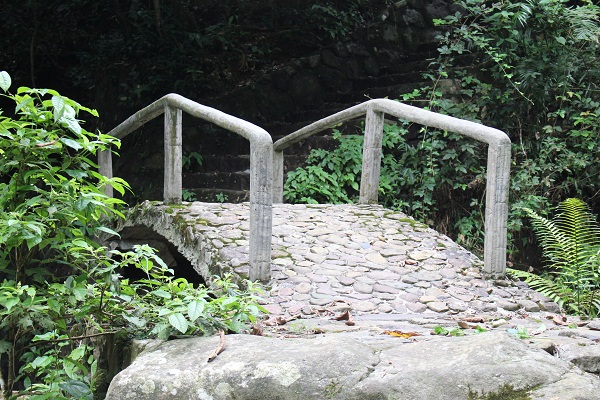
Do Kieu Historical Site.
DO KIEU: Located about 1,000 meters upstream from the Am Tra Shrine along the Phu Am Tra Stream, Do Kieu sits at the confluence of two streams that feed into the Phu Am Tra Stream. It marks the end of a relatively flat path, beyond which one must climb steep and long slopes to reach Ngoa Van Hermitage, flanked by deep valleys and only accessible on foot. This spot is known as Do Kieu because it was the resting place of the sedan chair of Emperor Tran Nhan Tong (Phat Hoang). From here, people had to leave their sedan chairs and continue on foot. The name Do Kieu is a variation of "Do Kieu," meaning "Resting Place of the Sedan Chair."
Do Kieu consists of two areas: the Flat Area and the Do Kieu Slope Area.
Flat Area: This is a flat region used for activities, featuring structures and gardens.
Do Kieu Slope Area: This area is dedicated to worship.
Thong Dan: This cluster includes three historical sites known as Thong Dan 1, Thong Dan 2, and Thong Dan 3, situated on three mountain slopes extending southwest of Dragon Enclosure Mountain, at elevations ranging from 430 to 480 meters above sea level.
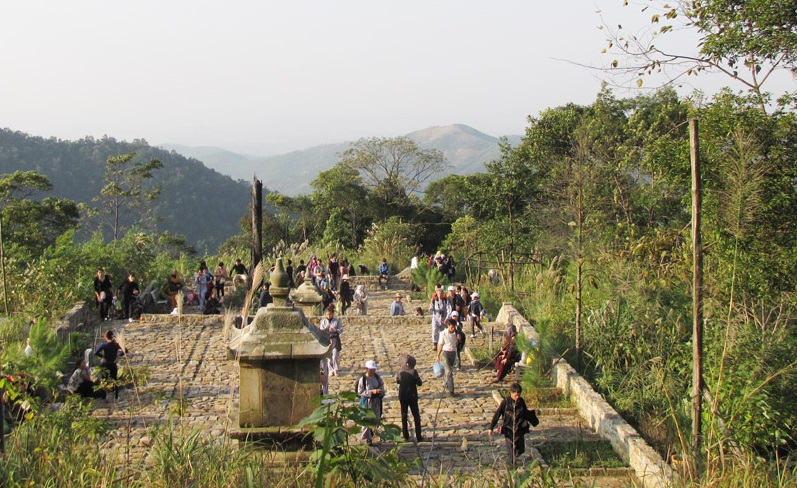
Thong Dan Area: A Rest Stop for Pilgrims on the Way to Ngoa Van Hermitage.
The name "Thong Dan" can be explained in two ways: first, it refers to the area being filled with ancient pine trees; second, because these ancient pine trees have large trunks and canopies, when the wind blows, the sounds created resemble a musical ensemble, with each pine tree acting as a musician, hence the name "Thong Dan" (Pine Orchestra).
All three Thong Dan historical sites have architectural remains from the Tran to the Le and Nguyen dynasties. Thong Dan 1 is located in the middle and on the main path leading to Ngoa Van Hermitage, serving as the central axis of the Thong Dan area.
During the Le Trung Hung period, Thong Dan 1 was renovated with two levels of foundation and two new stone towers. The first tower, built on the upper level, was dedicated to Buddha (Phung Phat Tower), and the second tower, on the lower level, was the tomb of the Zen master named Vien Man Chan Giac, hence also known as the Vien Man Chan Giac Zen Master Tower. These two towers stood until the 1980s when they collapsed. In 2012, alongside the reconstruction of the entire Thong Dan 1 site, the towers were also restored, marking the beginning of the restoration and enhancement of the Ngoa Van historical area.
Ngoa Van Area Historical Sites
NGOA VAN 1:
Located on the eastern spur of Dragon Enclosure Mountain, this site is the eastern "Tay Ngai" (Left Green Dragon). Remnants include a foundation of sandstone (rice stone), pebbles, and various artifacts. Ngoa Van 1 was an important Pagoda-hermitage in the Ngoa Van complex, featuring solid architecture, stone-paved foundations, wooden column frames, and lotus-tiled roofs.
NGOA VAN 2:
Situated about 20 meters northwest of Ngoa Van 1, this area primarily contains remnants such as column bases, bricks, and tiles. It is a significant part of the Ngoa Van site, located adjacent to the central Ngoa Van area.
NGOA VAN 6:
Approximately 500 meters east of the main Ngoa Van area, along the path from Da Chong to the Pagoda and about 20 meters higher to the north. Here, architectural foundations and a stone-stepped pathway leading up from the mountain's base are visible. This rectangular, flat area, covering about 42 square meters, is bordered by stone-paved sides and backs onto the mountain slope. Artifacts such as glazed ceramics and earthenware dating back to the Le Trung Hung period (17th-18th centuries) suggest that Ngoa Van 6 was first constructed during this period, when Ngoa Van was restored and expanded in the early 18th century.
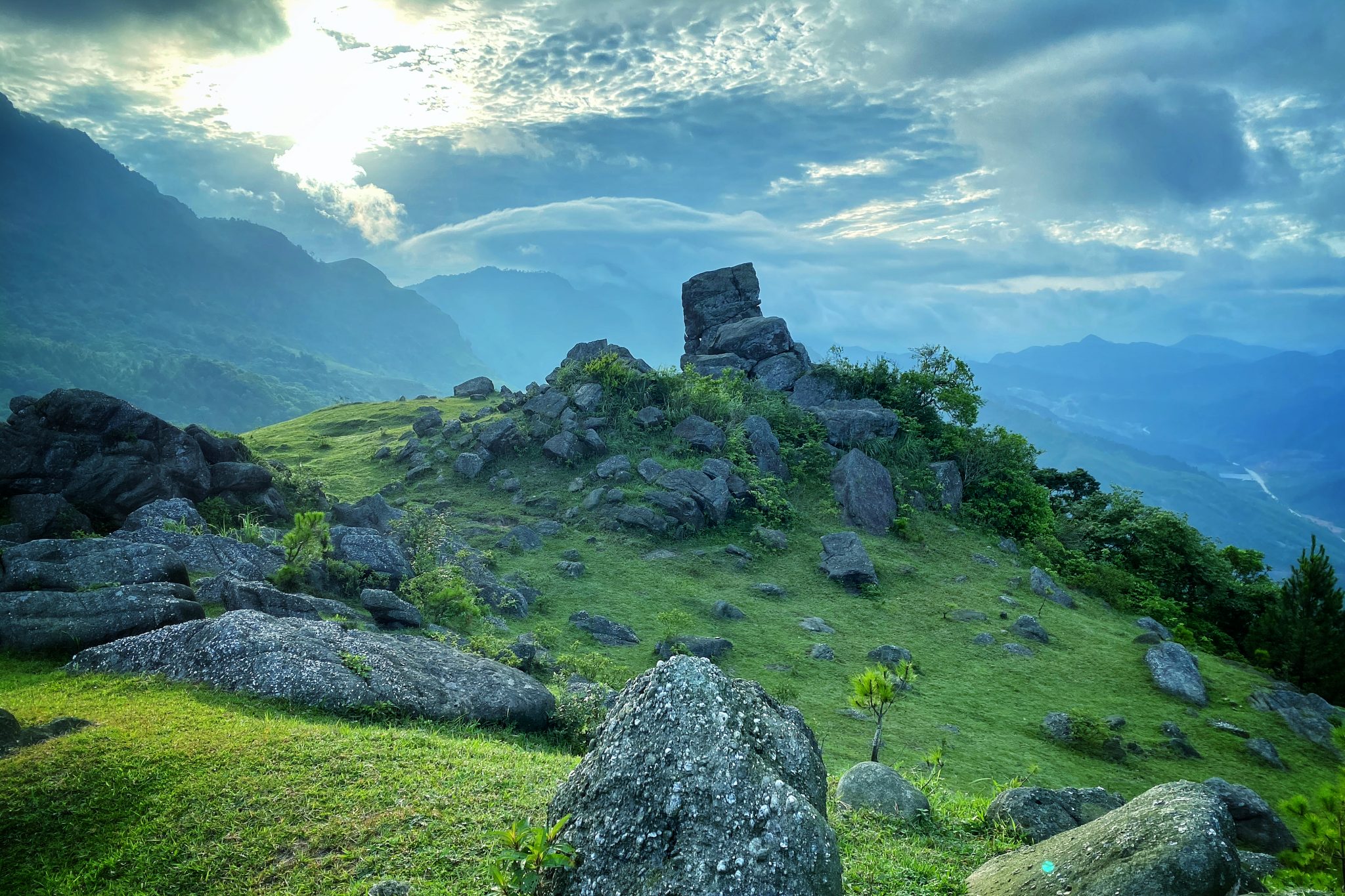
Da Chong Area at the Foot of Bao Dai Mountain
DA CHONG AREA:
The Da Chong area is a complex of structures within the Ngoa Van historical complex, situated on Bao Dai Mountain, approximately 3 km from Ngoa Van Pagoda via a trail, located on the southeastern slope of the Deo Voi area.
The name "Da Chong" (Stacked Rocks) originates from the area's characteristic rock formations at the mountain's peak, where rocks are precariously stacked upon each other.
In 2007, archaeologists discovered numerous architectural foundation traces and raw material production areas at this site, used for constructing the architectural works within the Ngoa Van complex. The site is divided into two areas: Da Chong 1 and Da Chong 2.
Da Chong 1:
Surrounded by mountains in the Deo Voi area to the northeast and southwest; to the northwest is a high mountain range, with the Da Chong peak to the southeast, and the distant Ben Chau Lake. The remnants in this area include:
Khu Chuong Bo (Cattle Shed Area): Located on the northwest side of Da Chong Mountain, this area stretches from the mountain's base to its peak and includes a water reservoir, a tower garden, a central area, and a secluded retreat facing southeast.

Water Reservoir: This reservoir collects water from multiple streams flowing down from the high mountain slopes.
Tower Garden: This area features traces of a large stone tower, with a structure similar to the tower of Emperor Tran Nhan Tong, a Buddha worship tower, and the Doan Nghiem Tower.
Central Area: Situated just beyond the tower garden, separated by a small stream about 5 meters wide. The central area has a rectangular layout oriented northwest to southeast, comprising a front courtyard, the first architectural structure, a middle courtyard, and a second architectural complex.
Secluded Retreat: This consists of two nearly square architectural bases, each covering an area of 25 square meters, one located halfway up the mountain slope and the other at the mountain peak.
Pagoda Garden: Positioned to the northeast of the central area, this garden is now overgrown with forest vegetation. However, remnants of a pebble-paved path and some planted trees can still be identified.
DA CHONG 2: This area is relatively flat, located on the southwestern slope of Da Chong Mountain, with traces of two architectural bases and a tile kiln from the Le Trung Hung period.
Historical Significance: The Da Chong area served as a production site for bricks and tiles used in constructing the Ngoa Van complex. Built in the 18th century, Da Chong 1 is the central area, chosen for its beautiful flat terrain and favorable natural and spiritual feng shui elements, including water convergence in the front and a high mountain in the back. Da Chong 2 housed smaller architectural structures and production facilities.
During the resistance against French colonial forces, Da Chong was a revolutionary base that sheltered the Hai Phong City Party Committee during French raids, serving as a rear base for the Dong Trieu battlefield. Therefore, Da Chong is a site of historical, cultural, and revolutionary significance.
Today, at the summit of "Bao Dai Mountain," Ngoa Van remains shrouded in mist throughout the year, preserving "Ngoa Van Hermitage," where Emperor Tran Nhan Tong is worshipped and "Phat Hoang Tower," where his relics are housed. The Ngoa Van Spring Festival runs from the 9th day of the first lunar month to the end of the third lunar month each year, offering an opportunity for pilgrims and visitors from around the world to visit this sacred Buddhist site.
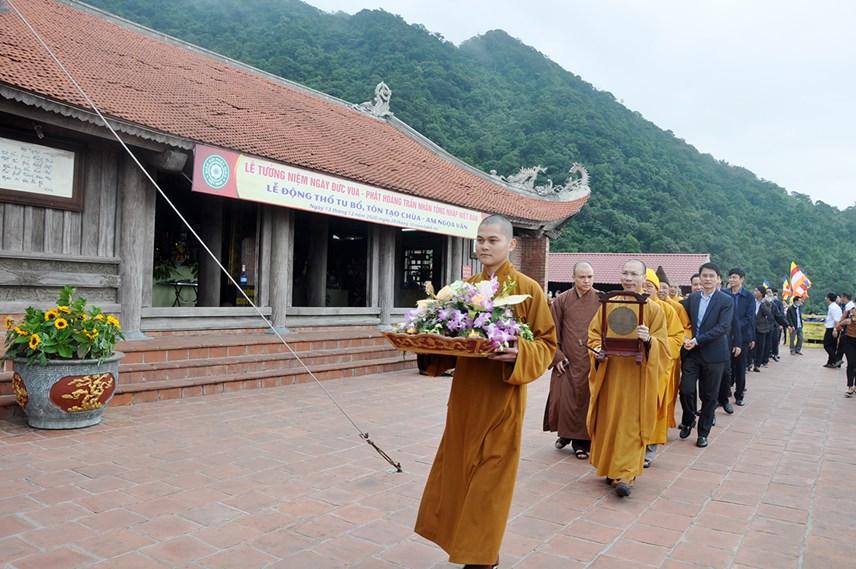
Commemoration of the 712th Anniversary of Emperor Tran Nhan Tong's Nirvana at Ngoa Van Pagoda
For hundreds of years, Ngoa Van Hermitage—where Emperor Tran Nhan Tong practiced and attained Buddhahood—has been considered the most sacred site, the Holy Land of Truc Lam Buddhism. It is an integral part of the Tran Dynasty relics in Dong Trieu town. The site was recognized as a special national relic according to Decision No. 2383/QĐ-TTg on December 9, 2013.
Pilgrims visiting this Buddhist land gain a deeper understanding of Emperor Tran Nhan Tong’s spiritual journey. They can also appreciate the natural beauty, finding peace and tranquility for their souls. Despite the challenging pilgrimage, the emotions evoked and the connection felt with the site are memorable. Visitors are not only captivated by the majestic and picturesque natural scenery of the mountainous region but also by the origin stories rich in Buddhist significance, offering reflections on life and a profound understanding of religion and existence.
Ngoa Van is a sacred and magnificent land. As winter approaches, embark on a pilgrimage to Ngoa Van for a beautiful and enriching experience, and to welcome a new year, 2022, filled with peace and happiness!


